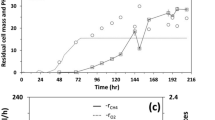Abstract
Three hydrocarbon uptake modes (adherence, emulsification and solubilization) were identified and quantified in cells and supernatants of a mesophilic marine bacterium Pseudomonas nautica strain 617 grown on eicosane. The adherence capacity was related to the enrichment of cells with wax esters and glycolipids. The emulsifying activity was related to the presence of extracellular biosurfactants composed of proteins, carbohydrates and lipids (35:63:2). The intensity of substrate uptake modes was sensitive to temperatures currently found in the original environment of P. nautica (16°C, 20°C and 32°C). When temperature decreased, a significant increase in adherence and emulsifying activity was observed in relation to biochemical changes, whereas solubilizing activity decreased. The marine bacterium was able to degrade 53–59% eicosane at the end of exponential growth after 13, 5 and 3 days incubation at 16°C, 20°C and 32°C respectively.
Similar content being viewed by others
References
Bertrand, J.C., Bonin, P., Goutx, M. & Mille, G. 1993 Biosurfactant production by marine microorganisms. Potential application to fighting hydrocarbon marine pollution. Journal of Marine Biotechnology 1, 125-129.
Bligh, E.G. & Dyer, W.J. 1959 A rapid method of total lipid extraction and purification. Canadian Journal of Biochemistry and Physiology 37, 911-917.
Bonin, P., Gilewicz, M. & Betrand, J.C. 1987 Denitrification by a marine bacterium Pseudomonas nautica strain 617. Annales de l' Institut Pasteur Paris 138, 371-383.
Dubois, M., Gilles, K.A., Hamilton, J.K., Rebers, P.A. & Smith, F. 1956 Colorimetric method for determination of sugars and related substances. Analytical Chemistry 56, 1272-1277.
Fernandez-Linares, L., Acquaviva, M., Bertrand, J.C. & Gauthier, M. 1996 Effect of sodium chloride concentration on growth and degradation of eicosane by the marine halotolerant bacterium Marinobacter hydrocarbonoclastus. Systematic and Applied Microbiology 19, 113-121.
Floodgate, G.D. 1984 The fate of petroleum in marine ecosystems. In Petroleum Microbiology, ed Atlas R.M. pp. 355-397. New York: Macmillan Publishing Company.
Goutx, M., Acquaviva M. & Bertrand, J.C. 1990. Cellular and exocellular carbohydrates and lipids from marine bacteria during growth on soluble substrates and hydrocarbons. Marine Ecological Progress Series 61, 291-296.
Kennedy, R.S. & Finnerty, W.R. 1975 Microbial assimilation of hydrocarbons II. Intracytoplasmic membrane induction in Acinetobacter sp. Archives of Microbiology 102, 85-90.
Kolattukudy, P.E. & Walton, T.J. 1973 The biochemistry of plant cuticular lipids. Progress in the Chemistry of Fats and Other Lipids 13, 121-175.
Reddy, P.G., Singh, H.D., Pathak, M.G., Bhagat, S.D. & Baruah, J.N. 1983 Isolation and functional characterization of hydrocarbon emulsifying and solubilizing factors produced by a Pseudomonas sp. Biotechnology and Bioengineering 25, 387-401.
Rosenberg, M. 1991 Basic and applied aspects of microbial adhesion at the hydrocarbon:water interface. CRC Critical Reviews of Microbiology 18, 159-173.
Roy, P.K., Singh, H.D., Bhagat, S.D. & Baruah, J.N. 1979 Characterization of hydrocarbon emulsification and solubilization occuring during the growth of Endomycopsis lipolytica on hydrocarbons. Biotechnology and Bioengineering 21, 955-974.
Sargent, J.R., Gatten, R.R & Henderson, R.J. 1981 Marine wax esters. Pure and Applied Chemistry 53, 867-871.
Williams, V. & Fletcher, M. 1996 Pseudomonas fluorescens adhesion and transport through porous media are affected by lipopolysaccharide composition. Applied and Environmental Microbiology 62, 100-104.
Author information
Authors and Affiliations
Rights and permissions
About this article
Cite this article
Husain, D., Goutx, M., Acquaviva, M. et al. The effect of temperature on eicosane substrate uptake modes by a marine bacterium Pseudomonas nautica strain 617: relationship with the biochemical content of cells and supernatants. World Journal of Microbiology and Biotechnology 13, 587–590 (1997). https://doi.org/10.1023/A:1018581829320
Issue Date:
DOI: https://doi.org/10.1023/A:1018581829320




